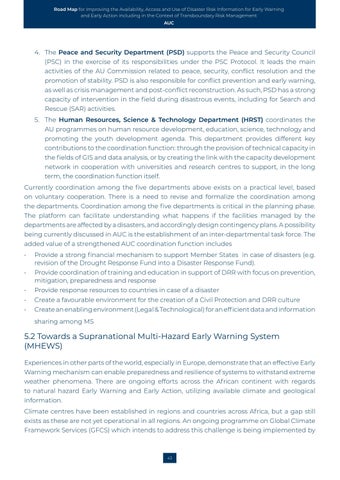Road Map for Improving the Availability, Access and Use of Disaster Risk Information for Early Warning and Early Action including in the Context of Transboundary Risk Management AUC
4. The Peace and Security Department (PSD) supports the Peace and Security Council (PSC) in the exercise of its responsibilities under the PSC Protocol. It leads the main activities of the AU Commission related to peace, security, conflict resolution and the promotion of stability. PSD is also responsible for conflict prevention and early warning, as well as crisis management and post-conflict reconstruction. As such, PSD has a strong capacity of intervention in the field during disastrous events, including for Search and Rescue (SAR) activities. 5. The Human Resources, Science & Technology Department (HRST) coordinates the AU programmes on human resource development, education, science, technology and promoting the youth development agenda. This department provides different key contributions to the coordination function: through the provision of technical capacity in the fields of GIS and data analysis, or by creating the link with the capacity development network in cooperation with universities and research centres to support, in the long term, the coordination function itself. Currently coordination among the five departments above exists on a practical level, based on voluntary cooperation. There is a need to revise and formalize the coordination among the departments. Coordination among the five departments is critical in the planning phase. The platform can facilitate understanding what happens if the facilities managed by the departments are affected by a disasters, and accordingly design contingency plans. A possibility being currently discussed in AUC is the establishment of an inter-departmental task force. The added value of a strengthened AUC coordination function includes •
Provide a strong financial mechanism to support Member States in case of disasters (e.g. revision of the Drought Response Fund into a Disaster Response Fund).
•
Provide coordination of training and education in support of DRR with focus on prevention, mitigation, preparedness and response
•
Provide response resources to countries in case of a disaster
•
Create a favourable environment for the creation of a Civil Protection and DRR culture
•
Create an enabling environment (Legal & Technological) for an efficient data and information sharing among MS
5.2 Towards a Supranational Multi-Hazard Early Warning System (MHEWS) Experiences in other parts of the world, especially in Europe, demonstrate that an effective Early Warning mechanism can enable preparedness and resilience of systems to withstand extreme weather phenomena. There are ongoing efforts across the African continent with regards to natural hazard Early Warning and Early Action, utilizing available climate and geological information. Climate centres have been established in regions and countries across Africa, but a gap still exists as these are not yet operational in all regions. An ongoing programme on Global Climate Framework Services (GFCS) which intends to address this challenge is being implemented by
43



